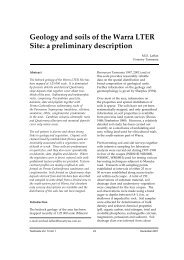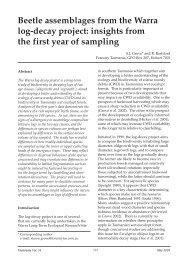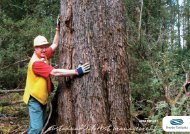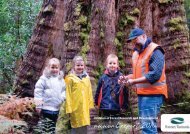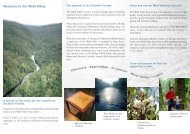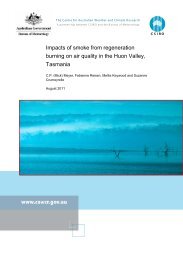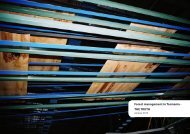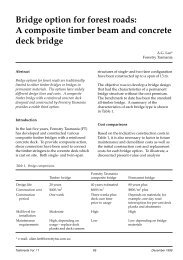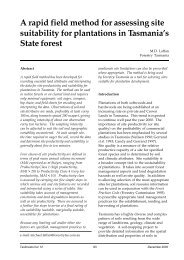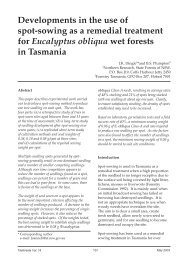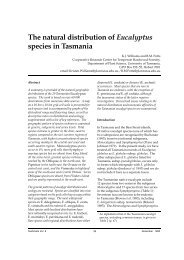annual report 2011 - Forestry Tasmania
annual report 2011 - Forestry Tasmania
annual report 2011 - Forestry Tasmania
Create successful ePaper yourself
Turn your PDF publications into a flip-book with our unique Google optimized e-Paper software.
Old trees: the elderly at the heart of the forest community<br />
Dr Simon Grove<br />
Simon.Grove@forestrytas.com.au<br />
Ten years ago, <strong>Forestry</strong> <strong>Tasmania</strong> initiated a<br />
comprehensive research program on the ecological<br />
importance and management of rotting logs, or<br />
coarse woody debris (CWD). Research on the internal<br />
composition of rotting logs has now put in place one of<br />
the final pieces of this program, and demonstrates that<br />
it’s not only in human societies that the elderly are the<br />
heart of the community.<br />
The various log decay classes are used to interpret<br />
forest stand dynamics and wildfire history, and to<br />
understand forest biodiversity values and carbon<br />
cycling capacity. Surveys or inventories of CWD<br />
attempt to categorise logs into discrete decay-classes<br />
based on readily observable features, but this assumes<br />
that the external appearance of a log is a good<br />
predictor of its internal state of decomposition. This<br />
study tests that assumption.<br />
A total of 64 Eucalyptus obliqua logs were selected from<br />
locations in the Warra Long-Term Ecological Research<br />
site, representing the full range of decay classes,<br />
from Class 1 (freshly fallen) to Class 5 (becoming<br />
incorporated into the soil humus layer). We assumed<br />
that a log’s diameter was a reasonable surrogate for<br />
its age, that is, that logs less than 60 cm diameter<br />
derived from regrowth-age trees and logs greater<br />
than 60 cm diameter derived from mature trees, and<br />
extracted three thin slices (‘biscuits’) from each log.<br />
Twenty different rotten-wood types were identified<br />
from the appearance of the wood (texture, colour,<br />
feel and smell). Decay by brown-rotting fungi (which<br />
preferentially attack cellulose, leaving lignin) was<br />
distinguished from decay by white-rotting fungi<br />
(which attack both cellulose and lignin), and the<br />
proportion of each biscuit occupied by each rottenwood<br />
type or airspace and the extent of biomass loss<br />
were measured to determine how well the decay-class<br />
system reflects a log’s internal state of decomposition.<br />
There was a strong relationship between a log’s<br />
externally determined decay-class and its loss of mass.<br />
This accords with earlier studies that showed that a<br />
log’s decay-class gives a good indication of how long<br />
it has been decomposing. Since a log’s relative mass<br />
is related to its carbon content, this gives information<br />
on the contribution that rotting logs make to carbon<br />
cycling.<br />
However, a log’s external appearance can mask<br />
considerable internal variation in the proportions of<br />
individual rotten-wood types. Some of this variation<br />
is related to a log’s position on the continuum of<br />
decomposition from freshly dead wood to wood<br />
humus. But in addition we found that logs derived<br />
from regrowth-age trees decomposed differently<br />
from those derived from mature-age trees. Smaller<br />
logs presumed to be from regrowth-age trees were<br />
more likely to have decayed from the sapwood<br />
inwards towards the heartwood, and to have<br />
decayed predominantly by white-rotting fungi.<br />
Larger logs derived from mature-age trees were<br />
more likely to have decayed from the heartwood<br />
outwards towards the sapwood, and to have<br />
decayed predominantly by brown-rotting fungi.<br />
These apparently simple differences between<br />
logs of different sizes, and this of potentially<br />
different origins, have important ecological and<br />
management implications. They also help account<br />
for the findings of other studies at Warra that<br />
highlighted the biodiversity differences between<br />
regrowth-age and mature-age trees and the logs<br />
arising from them. Mature-age trees harbour more<br />
species, and more unique species, than regrowthage<br />
trees, and the same applies to the logs derived<br />
from these trees. Mature-aged trees are in many<br />
ways the heart of the forest community, and<br />
forests lacking them will lack a large amount of<br />
their potential biodiversity.<br />
10




